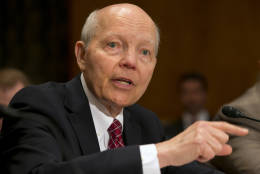Hiring/Retention
-
Senior Correspondent Mike Causey explains how a government layoff is like cutting your own hair in a small boat during a storm.
April 07, 2017 -
The Internal Revenue Service continues to think of ways to modernize its IT systems and navigate the dangerous waters of identity theft and refund scams, —, even as the agency is being asked for a seventh year to tighten its belt.
April 05, 2017 -
Sens. Heidi Heitkamp (D-N.D.) and Gary Peters (D-Mich.) asked that the Government Accountability Office to conduct a full review of President Donald Trump's temporary hiring freeze. Citing GAO's past study of previous hiring freezes, both senators said they're concerned the current freeze isn't saving government more money and is prompting more agency inefficiencies.
April 05, 2017 -
The Office of Management and Budget is developing a new IT capital planning policy that would help agencies measure, manage and budget IT investments. Training is another key component of OMB's strategy during the transition year, as it also will help agencies overcome cybersecurity recruitment and procurement challenges.
April 05, 2017 -
A 31 percent cut to the Environmental Protection Agency's budget in fiscal 2018 would force EPA to cut nearly 4,000 full time equivalent employees, begin cost-saving IT modernization projects and reduce the agency's physical footprint. New budget documents describe funding levels and policy decisions at EPA that would support the President's 2018 budget request.
April 03, 2017 -
The Navy needs 2,000 civilians to deal with its ship maintenance backlog and even more if the fleet size increases.
April 03, 2017 -
The Defense Department has carved a bug bounty path that civilian agencies can follow on their own, as long as they don't try to compare their results to the same level as DoD.
March 30, 2017 -
Senior Correspondent Mike Causey says that on the heels of the hiring freeze, there are fears that layoffs may be in the future.
March 30, 2017 -
The Department of Homeland Security told Congress Tuesday that it’s seeing significant dividends from a new legal authority Congress granted the department in 2014: the ability to force other federal agencies to take concrete steps to improve their cybersecurity posture.
March 29, 2017 -
About 8 percent of federal employees say they're fully confident in their agency's talent management system, according to a recent survey of more than 300 employees. But human capital experts are wondering whether the triple threat of budget cuts, attrition and a government reorganization could push agencies to address longstanding human capital questions they've avoided in the past.
March 28, 2017 -
When the hiring freeze started there were about 8,500 vacancies across the Air Force and the service was taking on about 1,300 each month.
March 28, 2017 -
Why is the federal hiring process so bad? And what would it take to make it work? Jeff Neal, former chief human capital officer at DHS, takes a look in Part 1 of his two-part commentary.
March 28, 2017 -
The Air Force alone is dealing with a shortage of more than 600 pilots. The service is having trouble competing with airlines that can pay pilots more.
March 27, 2017 -
The Office of Personnel Management released a new guidebook on how agencies should begin preparing for workforce reshaping efforts. It also updated key documents on issuing administrative furloughs. Both guides are designed to help agency heads implement possible reductions in force or furloughs so that they comply with the law and do the least damage.
March 24, 2017 -
Three top Air Force generals told Congress that manpower issues were the greatest challenge to the organization’s readiness. While specific concerns varied between the USAF, the Reserves and the Air National Guard, each agreed that recruiting and retention is their top priority.
March 23, 2017














